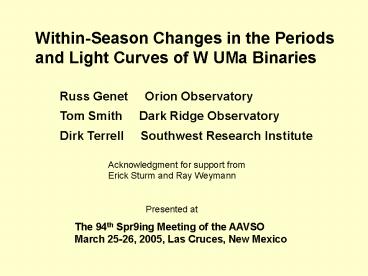WithinSeason Changes in the Periods
1 / 39
Title: WithinSeason Changes in the Periods
1
Within-Season Changes in the Periods and Light
Curves of W UMa Binaries
Russ Genet Orion Observatory Tom Smith
Dark Ridge Observatory Dirk Terrell
Southwest Research Institute
Acknowledgment for support from Erick Sturm and
Ray Weymann
Presented at
The 94th Spr9ing Meeting of the AAVSO March
25-26, 2005, Las Cruces, New Mexico
2
Overcontact Binaries
- Common envelope with mass and luminosity
transfer between the two stars - Convective (W UMa) and Radiative Envelopes
- Tend to have period and light curve variability
3
W UMa Systems
OC Systems with convective envelopes are the W
UMa systems
4
Early-type Systems
OC Systems with radiative envelopes do exist,
e.g. TU Mus
5
Planets?
W UMa systems have several characteristics that
make them favorable for the development of
habitable planetary systems.
6
Light Curve Variability
7
Inexpensive Equipment
- Meade 10 LX200
- SBIG ST-7XE CCD
- UBVRCIC Filter Set
8
The Wilson-Devinney Program
- First published in 1971 by Bob Wilson and Ed
Devinney - Still being developed. New version uses filter
bandpasses rather than effective wavelengths.
Adds Kurucz atmospheres. - Uses modified Roche model to compute figures of
the stars. Can model stars with eccentric orbits
and non-synchronous rotation. - Can do light curves, radial velocity curves and
spectral line profiles. Unpublished versions have
added ability to model polarization curves,
fluorescence and X-ray pulses. - Consists of two programs
- LC computes light curves given a set of
parameters - DC fits light curves to observations using the
method of differential corrections
9
Program Objectives
Looking for subtle changes in light curve shapes
and eclipse timing Within season
Between seasons Light curve shape changes
could be due to Starspots Bright
steaming Observational errors Eclipse
timing changes could be due to AML
Applegate Micro MT episodes Third bodies
Obs error
10
Program Approach
Make lots of observations Worry precision, both
timing and photometric Taylor analysis to the
situation Learn and refine
11
Make Lots of Observations
Total Dedication Multiple Observatories Binarie
s Few Short period North
Strategy Maximize Observing Time Nightly
(airmass) Seasonal (dew) Semi-Automation
Observations Reduction Analysis
12
(No Transcript)
13
(No Transcript)
14
(No Transcript)
15
(No Transcript)
16
Pilot Season Observations
Binary DRO Orion Total V523 Cas
31 15 46 RW Com 18 8
26 V400 Lyr 7 10 17 TZ Boo
18 13 31 V1191 Cyg 22
39 61 GM Dra 14 3
17 Totals 110 88
198 Obs/Night x640 x320 Total Obs 70K
28K 98K
17
(No Transcript)
18
(No Transcript)
19
(No Transcript)
20
Make Lots of Observations
Total Dedication Multiple Observatories Binarie
s Few Short period North
Strategy Maximize Observing Time Nightly
(airmass) Seasonal (dew) Semi-Automation
Observations Reduction Analysis
21
Worry Precision
Timing Precision Clock / time recorded
Shutter Barycentric correction Photometric
Precision Model (Howell Young) Brightness
(program comps) Same position / instrument
Flats, transformations Guiding, defocus,
dither
22
Aperture Experiment
23
Erick Sturm Cal Poly
24
(No Transcript)
25
(No Transcript)
26
Taylor Analysis
Light Curve Shapes Parametric / nonparametric
Simple statistics / entire curves Smoothing /
point by point Single nights / grouped
nights Eclipse Timing Errors (internal /
external) Minimize seasonal scatter
Interactions / Cuts Part curve / whole curve
Hertzsprung method Sliding whole-curve fits
Master curves / Tsesevich Seasonal ephemeredes
27
Hertzsprung Method
28
(No Transcript)
29
(No Transcript)
30
(No Transcript)
31
(No Transcript)
32
Number of Points 32 Standard Deviation 4.3
sec Std Error of Mean 0.8 sec
33
Learn and Refine
Lots of Observations Aperture Simultaneous
color bands More complete automation
Precision Aperture Simultaneous color bands
Various refinements Analysis Feedback
34
MTT
Multiple Tube Telescopes
U
B
B
V
c
c
V
I
I
R
R
Five Banger
Four Shooter
35
Two-Channel Dichroic
36
Four Color
37
Potential Throughput
Observations this past season 98K
Observations this coming season 8 months 20
obs/month 2 observatories 320 nights 320
(Orion) 640 (Dark Ridge) 1000 obs/night 320
nights 1000 obs / night 320K Obs Say 180K obs
2005 season If 3 binaries, then 60K obs/binary
10 to 20 x 4 1 filt to 2 filt x 2 14 to
20 x2 1 filt to 2 filt x 2
2.5 K obs/night each Total of 5K obs/night 320
nights/season 1.6Meg obs/season If 3 binaries,
then 533K obs/binary/season
38
Potential Precision
32 nights 15K observations Yielded 0.8 sec
SD 533K obs possible 2 ea .5-m 2 flts 533K/15K
34.7 Sqrt 34.7 5.8 0.8/5.8 0.14 sec If
ensemble 2 then Sqrt 2 factor 0.14/Sqrt2 0.1
sec If 4 instead of 2 0.1/Sqrt2 0.07 sec
39
Learn and Refine
Lots of Observations Aperture Simultaneous
color bands More complete automation
Precision Aperture Simultaneous color bands
Various refinements Analysis Feedback































